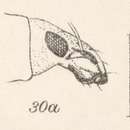Description
provided by INOTAXA archive
♀. Elongate, black, shining; above thickly clothed with cupreo-cinereous, the lower surface with whitish, scales, the scales on the elytra here and there condensed into denser patches which are separated by small partially denuded spaces (? abraded), and also set with short, scattered, decumbent, whitish setæ. Head and rostrum canaliculate, the rostrum longer than broad and with the upper portion parallel-sided; eyes very large, somewhat depressed, oval as seen from above; antennæ slender, the scape feebly clavate at the tip, joint 2 of the funiculus twice as long as 1. Prothorax about as long as broad, subcylindrical, obliquely narrowed anteriorly, interruptedly canaliculate; with coarse scattered punctures intermixed with a fine interstitial punctuation. Elytra elongate, subparallel to beyond the middle, the humeri prominent; coarsely punctate-striate (the punctures appearing fine where covered by the scales), the interstices flat on the disc, feebly convex towards the sides and apex.
Length 10½, breadth 3 2/3 millim.
- license
- cc-by-3.0
- copyright
- Biologia Centrali-Americana
Distribution
provided by INOTAXA archive
Hab.GUATEMALA, Cerro Zunil, Pacific slope (Champion).
- license
- cc-by-3.0
- copyright
- Biologia Centrali-Americana
Physical description
provided by INOTAXA archive
One specimen. More elongate than P. cupreoviridis, the antennæ more slender, the eyes depressed, the elytra relatively longer, with the setæ shorter and decumbent, the scales uniformly coloured. This species is extremely like Exophthalmus distigma, an insect occurring in abundance at the same locality, but it is separable at a glance by the superior scrobes, the longer, 10-striate elytra, and the dentate anterior femora.
- license
- cc-by-3.0
- copyright
- Biologia Centrali-Americana

